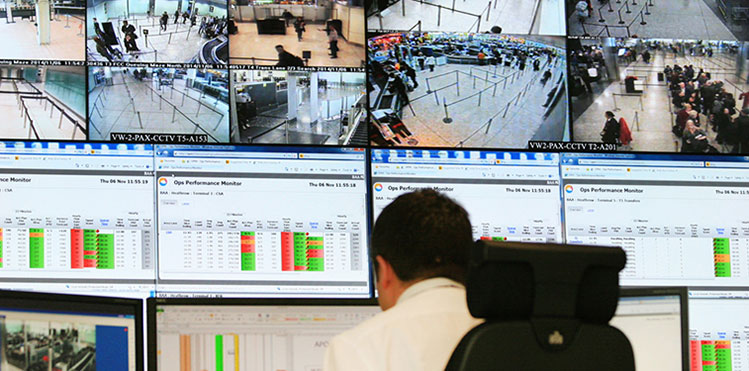Airport operations centres (APOCs) are expected to become the nerve centres of future airports, allowing an unparalleled overview of operations and allowing effective, fast decisions on how the airport can function most efficiently, especially under challenging circumstances. In this article, Florian Guillermet, Executive Director of the SESAR Joint Undertaking, explains the steps taken by European partners to move beyond airport collaborative decision-making (A-CDM) to deliver the APOC and total airport management (TAM).
Airports are busy and complex environments to manage, involving a multitude of operations and stakeholders that need to be synchronised to ensure the best possible passenger experience. They are also essential nodes within an intricate airspace Network, ensuring seamless traffic flow. Needless to say then that if disruption hits an airport – especially a major hub – then it can have a significant knock-on effect on the rest of the Network.

Florian Guillermet, Executive Director of the SESAR Joint Undertaking.
Airport collaborative decision-making (A-CDM) is seen as a means to address disruptions by better sharing information locally between stakeholders such as airport operators, ground handlers and air traffic control. A-CDM is also about sharing information with the Network Manager to enhance the air traffic flow and the capacity management in the European airspace.
A total of 22 airports across Europe, accounting for a third of all departures, have already implemented A-CDM, resulting in important local benefits including reduced push-back delays, shorter taxi-out times, better use of ground handling resources, fewer late stand/gate changes and increased peak departure rates. At the network level, a recent study1 estimated that the implementation of A-CDM results in savings of over 34,000 tonnes of fuel per annum and has the potential to increase en-route capacity by more than 3.5%.
These results clearly show that A-CDM pays off, which is why at SESAR we wanted to evolve the concept even further. Together, our SESAR partners have come up with the airport operations centre or APOC. Organised as a physical or virtual centre, the APOC provides stakeholders, including airlines, ground handlers, air traffic control, security, emergency services and airport management, with a set of commonly agreed performance indicators in order to take decisions. These indicators are drawn from the airport operations plan (AOP), which includes a range of information from airside processes and those landside processes impacting air traffic management, such as passenger flow data and meteorological data.
Using a real-time monitoring system, a decision-support system and a set of standard, collaborative procedures, the APOC staff can continuously monitor the AOP and detect and even anticipate deviations from the plan and potential disruptions. They can then take corrective action in advance to maintain performance even in adverse weather or exceptional conditions. As stakeholders update their intentions, or accurate flight progress information is received, the AOP is refined and used to manage resources and coordinate operations. In other words, the APOC offers stakeholders a very transparent picture of what is happening at the airport and provides them with the means to work together to deal with situations before they become real problems.
The APOC also connects the AOP with information from the Network Operations Plan (NOP), a comprehensive global plan for the network. This is critical step to improving the accuracy of short-term air traffic flows in the network, as well as enabling improved target time coordination and decision-making. The combination of AOP and NOP increases predictability across the network and, of course, at individual airports. Ultimately, both empower airports to be the ground coordinators of their local operations but also the Network at large. And better predictability means reduced delays, unnecessary fuel burn and cost savings for airlines and better services for passengers.
SESAR validations2, including live trials taking place in large hubs as well as airports with high seasonal traffic, showed the feasibility of integrating a variety of processes into the AOP and connecting it to the NOP. These two solutions are essentially the basis for building an APOC. The outcomes of this work have been so convincing in terms of improved predictability and more efficient airport operations that in 2014, London Heathrow and Paris Charles de Gaulle took the plunge and implemented initial APOCs. Other airports, such as Brussels Airport, have since followed suit.
Our work has shown that potential of APOC is reliant on information and lots of it. A study3 published in 2016 within the framework of SESAR, followed by a live trial at Heathrow, illustrated how integrating big data techniques into the APOC can provide accurate forecasts so that airports better understand the key factors that influence passengers’ connection time and reduce the risk of missed flights. In addition, better predictions of passengers’ transfer activities also improve the accuracy and stability of the target-off-block-time (TOBT), which is critical for optimised air traffic flow management in Europe. Put simply, these predictions allow stakeholders – the airport and airlines – to take strategic decisions, such as holding an aircraft at the gate so that delayed passengers can board and the consequences that this may have on traffic.

London Heathrow is among the airports to have taken the plunge and implemented initial APOCs. Copyright: Heathrow Airport
Of course, sharing data to allow for greater common situational awareness can have its drawbacks. Increased reliance on data also increases the risk of cyber attacks that disrupt airport operations. It is therefore vital to address cyber threats and look at how to mitigate them together. A study undertaken within the context of SESAR4 explored how cybersecurity should be addressed in the APOC. The study presented cyber-attack scenarios, ways of building trust between APOC partners, and approaches of sharing information on cyber-threats and risk. The study also provides a cyber-security maturity assessment tool with which airports can determine how resilient their operations are to cyber attacks. Cyber protection is among the elements that will be further investigated in SESAR 2020, the next wave of research and innovation. In collaboration with industrial partners, a security assessment will be performed on the APOC tools and prototypes in order to identify system vulnerabilities and data security risks.
SESAR 2020 will apply a “secured by design” principle to the delivery of all its airport solutions as it moves towards what is called “total airport management”. This holistic approach foresees closer integration of both landside and airside performance monitoring, combining data-derived trends for instance on meteorological conditions, flight prioritisation, runway traffic loads and turn-around times of aircraft, with data on baggage and passenger operations all leading to improved departure time predictability. The future APOC dashboard will rely on increasingly standardised data formats, enabled by system-wide information management, as well as big data in order to show ‘what has happened’, ‘what is happening’ but importantly ‘what is predicted to happen’.
Disruptions at a major European airport do not only significantly impact the airport itself but can also lead to delays and ramifications further down the line in the overall network. To address this, SESAR researchers will look at further connecting the Network Manager with individual APOCs, as well as the feasibility of coupling hub APOCs, looking at scenarios such as coordinating diversions of carriers from one hub to another. But the potential of APOC is not just for the large airports.
Smaller or regional airports can also benefit from this advanced collaborative-decision-making. These airports are key for local and regional sustainability and connectivity, however with limited resources, they have been unable to access this type of tooling to date. The goal therefore in SESAR 2020 will be to ensure that the APOC and total airport management is scalable so that only those elements bringing most benefit at an affordable level will be implemented locally.
SESAR is working closely with ACI EUROPE and SESAR European Airports Consortium (SEAC) to move towards APOC and total airport management for airports large and small. Rather than a closed club restricted to it members, SESAR encourages airports to participate in open calls for demonstrations that will be published in the coming two years on this topic.
Footnotes:
1. https://www.eurocontrol.int/sites/default/files/publication/files/a-cdmimpact-assessment-2016.pdf
2. Airport operations plan (AOP) and its seamless integration with the network operations plan
(NOP) – Contextual note
3. APOC Business Process Reengineering Big Data Study – Eurocontrol, University College London (UCL), University of Virginia and Heathrow Airport (Within framework of SESAR Project 06.03.01 / OFA05.01.01)
4. Addressing airport cyber-security – Eurocontrol, Helios, Groupe ADP and Professor Chris Johnson of the University of Glasgow (Within framework of SESAR Project 06.03.01 / OFA05.01.01)
SESAR
As the technological pillar of the Single European Sky initiative, SESAR aims to modernise and harmonise air traffic management in Europe. The SESAR Joint Undertaking (SESAR JU) was established in 2007 as a public-private partnership to support this endeavour. It does so by pooling the knowledge and resources of the entire ATM community in order to define, research, develop and validate innovative technological and operational solutions. The SESAR JU is also responsible for the execution of the European ATM Master Plan. Founded by the European Union and EUROCONTROL, the SESAR JU industry members, together with their partners and affiliate associations, represent over 100 companies working in Europe and beyond. The SESAR JU also works closely with staff associations, regulators, airport operators and the scientific community.
Find out more: www.sesarju.eu







